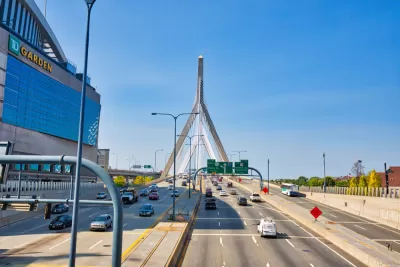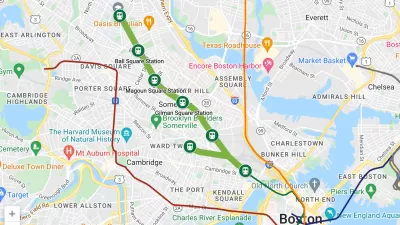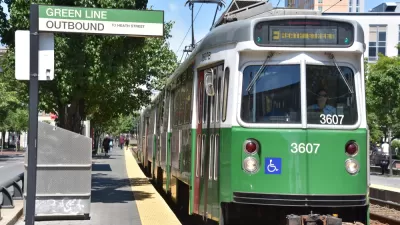Road planners looking to increase capacity without adding lanes are focusing on managing existing lanes more effectively. Massachusetts has gone the opposite direction. The Conservation Law Foundation plans to hold them accountable.

The conversion of a high occupancy vehicle (HOV) lane to a general-purpose, or unmanaged lane, on Interstate 93 north of Boston is not permanent, but it is still a violation of law, claims a distinguished New England environmental non-profit group with a long history of transportation advocacy.
"This past spring, Massachusetts transportation officials opened up the southbound carpool lane on I-93 — from Medford to the Zakim Bridge in Boston — to single drivers at all times as part of an effort to relieve traffic impacts from a two-year Tobin Bridge construction project," reports Nik DeCosta-Klipa for Boston.com. The construction closed lanes on U.S Route 1 over New England's largest bridge.
“With the daily traffic nightmare on our roads, opening this lane to all cars is short-sighted, slows commutes for bus riders, and violates the law,” said Staci Rubin, a senior attorney at the Conservation Law Foundation (CLF) who focuses on transportation advocacy, in the group's press release on Tuesday.
CLF delivered the notice of intent to sue today, and it can be found here [pdf]. The state has 60 days to respond before the lawsuit is officially filed.
CLF sued the state in the early 1990s to push for better transportation options as a result of the Big Dig. The settlement required a number of projects including the Green Line extension, the Red-Blue connector, and the creation and maintenance of high occupancy vehicle lanes.
According to an email from Jake O'Neil of CLF, MassDOT converted the HOV lane as a mitigation measure to deal with the congestion on U.S Route 1 caused by the Tobin Bridge lane closures, providing an alternative route for motorists originating from north of Boston.
"MassDOT does not plan to make this condition permanent as the opening of the I-93 southbound HOV lane in Somerville and Medford is one of several temporary measures being undertaken by MassDOT to relieve North Shore congestion for all travelers related to the Route 1 Chelsea Viaduct and the Tobin Bridge projects," the state agency said in a statement, reports Michael P. Norton of (Massachusetts) State House News Service. "MassDOT looks forward to meeting with CLF in the near future to address the group’s concerns."
Norton adds that CLF claims that the conversion "violated the Clean Air Act, state law and a Big Dig-era emissions settlement."
"The separated high occupancy vehicle (HOV) lane had previously been reserved for buses and cars with two or more people during the weekday morning commute (6 a.m. to 10 a.m.)," adds DeCosta-Klipa.
The state constructed HOV lanes on I-93 (there’s also one south of Boston) in the 1990s as part of an effort to make sure the Big Dig met state and federal clean-air laws, by providing drivers an incentive — potentially a quicker commute — to use more efficient means of transportation.
According to CLF, the decision to allow single drivers to use the HOV lanes, which was criticized by local transportation advocates at the time, has resulted in “significantly longer commute times” for the carpoolers and bus riders who used the lane.
Correspondent's note: In 1998, HOV lanes on I-287 and I-80 in New Jersey were converted to general-purpose lanes after a study found them ineffective, according to David Matthau of New Jersey 101.5.
Related in Planetizen:
-
Virginia Interstate Widening Would Convert Free Lanes to Toll Lanes, September 30, 2019
Hat tip to AASHTO Daily Transportation Update.
FULL STORY: Why a group is threatening to sue MassDOT over a change to an I-93 carpool lane

Trump Administration Could Effectively End Housing Voucher Program
Federal officials are eyeing major cuts to the Section 8 program that helps millions of low-income households pay rent.

Planetizen Federal Action Tracker
A weekly monitor of how Trump’s orders and actions are impacting planners and planning in America.

The 120 Year Old Tiny Home Villages That Sheltered San Francisco’s Earthquake Refugees
More than a century ago, San Francisco mobilized to house thousands of residents displaced by the 1906 earthquake. Could their strategy offer a model for the present?

HSR Reaches Key Settlement in Northern California City
The state’s high-speed rail authority reached an agreement with Millbrae, a key city on the train’s proposed route to San Francisco.

Washington State Legislature Passes Parking Reform Bill
A bill that would limit parking requirements for new developments is headed to the governor’s desk.

Missouri Law Would Ban Protections for Housing Voucher Users
A state law seeks to overturn source-of-income discrimination bans passed by several Missouri cities.
Urban Design for Planners 1: Software Tools
This six-course series explores essential urban design concepts using open source software and equips planners with the tools they need to participate fully in the urban design process.
Planning for Universal Design
Learn the tools for implementing Universal Design in planning regulations.
Ada County Highway District
Clanton & Associates, Inc.
Jessamine County Fiscal Court
Institute for Housing and Urban Development Studies (IHS)
City of Grandview
Harvard GSD Executive Education
Toledo-Lucas County Plan Commissions
Salt Lake City
NYU Wagner Graduate School of Public Service





























